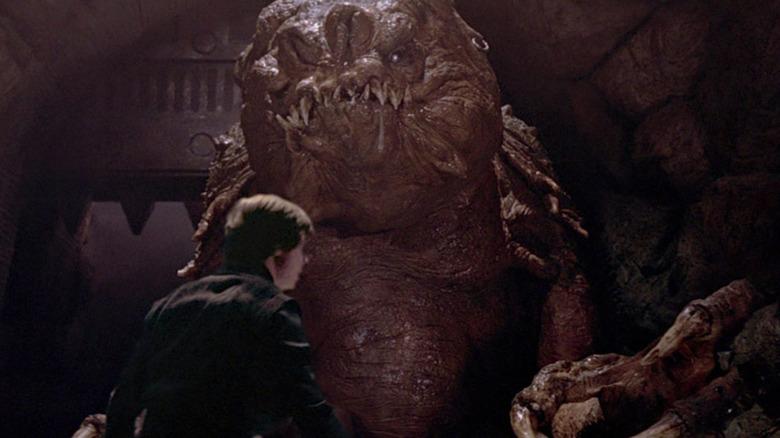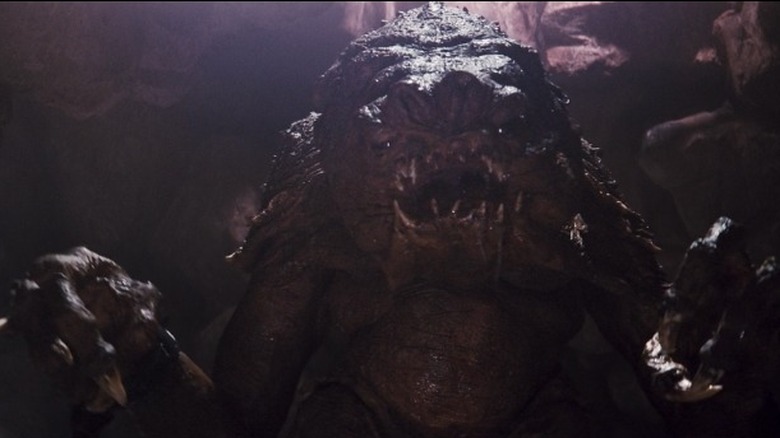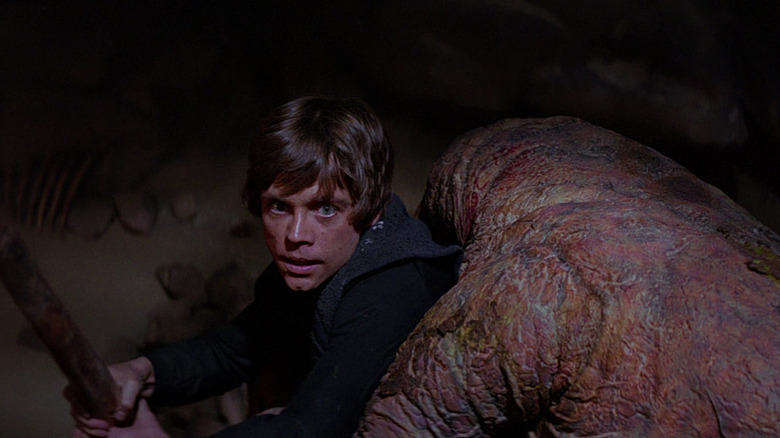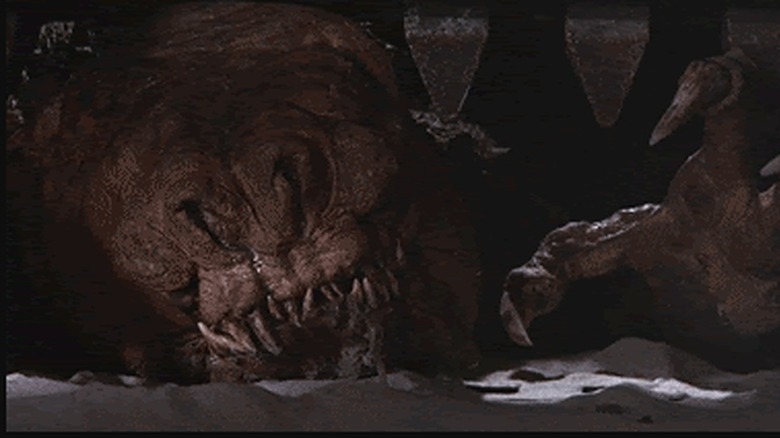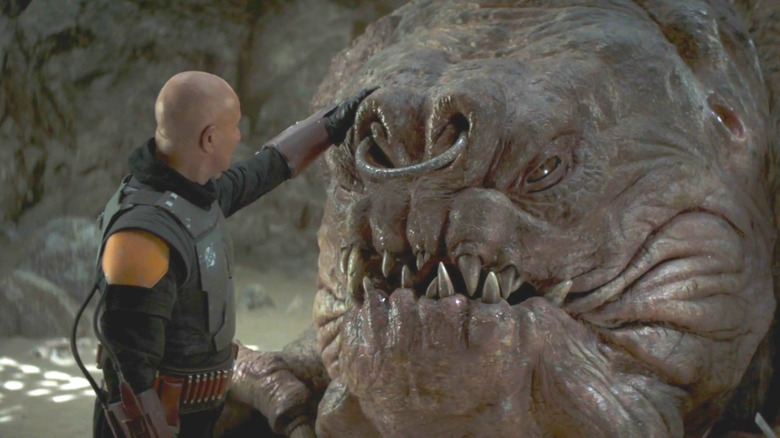Figuring Out How To Pull Off Return Of The Jedi's Rancor Scene Was An Exhausting Task
From the moment audiences caught a glimpse of its gargantuan form in "Return of the Jedi," the rancor has remained a creature favorite in that galaxy far, far away. It rode the line between terrifyingly monstrous and unprecedented awesome as sci-fi monsters went in the '80s. Prior to seeing the movie, I never had a preferred beast of the "Star Wars" universe – but that changed the moment the Rancor stepped out of the shadows in all its grisly glory.
Unsurprisingly the wizardry that went into bringing the Rancor to life relied on many of the same practical-effects techniques used to create some of "Star Wars" most breathtaking moments. But Dennis Murren and Phil Tippet quickly realized that the Rancor, although a small part of the film's opening act, would prove to be one of the biggest challenges the special-effects team on "Return of the Jedi" would face. They also had to keep the film's budget from ballooning which prevented the use of a new technique but an expensive technique called go-motion. So Murren, Tippet, and all the magic makers at Industrial Light & Magic (ILM) did what they do best: trial and error.
A rancor suit made for two
How exactly do you construct what's supposed to be a sixteen-foot tall dungeon-dwelling monster? Remember this is a decade before "Jurassic Park," a film that saw Tippet create large-scale dinosaurs and also had double the budget of "Return of the Jedi" — a whopping $63 million. In an interview posted on StarWars.com, it was revealed that George Lucas thought a man in a suit could convincingly play the Rancor. Murren and Tippet had less than high hopes:
"We tried that originally with a guy in a suit. George thought that might work, and Phil and I were thinking, 'This will never work.' But as we got into it, we made a suit that a couple of guys could work with. It was one creature but really being controlled by two people inside of it. It was as big as a person actually is, so it was not a rod-puppet or anything. And it started looking pretty neat."
You can actually see footage of what that costumed Rancor looked like and to be completely honest – it doesn't look half bad. Sure it's a little wobbly and unfinished but it looks almost remarkably similar to the finished product you see in "Return of the Jedi." Ironically when Lucas saw the costume he agreed with Murren and Tippet's prediction. The only problem was that both men were "pretty exhausted" at this point of doing both go-motion (which was too pricey) and stop-motion. So they scrapped the costume and went back to the drawing board before landing on a "Star Wars" creature-effects staple: the puppet.
Shrinking down the rancor to a puppet
One of the most iconic examples of creature effects in "Star Wars" is of course Yoda, who was made animate by a puppet controlled and voiced by Frank Oz. The character was so life-like that its replacement with CGI decades later in "Attack of the Clones" would be schismatic. If it worked for Yoda it could work for a rancor, right? "I think Phil came up with the idea of doing it with a rod-puppet," Murren explained. "And that was kind of good. We could hide the rods in the darkness and set the shots up to look like the creature was big." But Murren is rather critical of the creature's appearance even as a puppet:
"Right away it looks like it's a muppet or a hand puppet. Even when you're a kid and you stick a sock puppet on your hand, you know what that looks like. It's embedded in your mind, and this looked like that. We saw that, and we did everything we could in every shot to have it not look like that. Shooting high speed, shooting slow speed, or shooting things backwards, because bodily, your muscles work differently...It was not really a big sequence. It was a tiny little set with five people jammed into it."
Although just two feet tall the puppet was operated by five people from beneath it — just like Yoda. Murren's critique also hinges on people recognizing the movements of a puppet as a dispelling quality of the rancor. But given the decades since and dominance of CGI, practical effects like puppets can sometimes have the opposite result with modern audiences. In my experience most "Star Wars" fans see the rancor scene as one that holds up over time as much as any of the other special effects in "Return of the Jedi."
The limitations of an '80s rancor
Looking back, Murren actually admits that in comparison stop-motion would've been a less exhausting route for creating the rancor. The technique, which requires an immense amount of patience on the animator's part, recently made a comeback when Tippet revealed he worked on "The Mandalorian."
"You know, stop-motion probably would have been actually the easiest. It's time-consuming, but you kind of know what you're going to get. It's harder for the animator, and that's not me, but I think the results came out a lot better with what we ended up doing with rancor."
That being said – Murren also understood that the rancor they created for "Return of the Jedi" couldn't exactly do all the things a stop-motion or even CGI version of the rancor might. He continued:
"I mean, every time I see it, and I haven't seen it that much, I feel very limited in what it could do. I want to be back looking at it more, and I want to see it just doing something, and it doesn't. And it's because it can't. With that technology, that's the most it could do. And that's all it really needed to do, anyway."
Part of what Murren is describing is the imagination of the audience, which was shown only convincing parts of a whole creature in "Return of the Jedi" and ran with it. What more do you need to see besides that gangly face, the grotesque slobber running down sharp teeth, its beady shark eyes, and gargantuan claws? Like Murren says, all it needed to do was terrify and it did just that. But like Yoda, it also created an enduring image that would eventually lead to the rancor's long-awaited return.
Return of the rancor
Hopefully, Murren caught the first season of "The Book of Boba Fett," which brought back the creature with no small fanfare. It made sense given the fact that Fett had taken over Jabba's Palace and a Danny Trejo cameo as the rancor keeper was an exquisite cherry-on-top. But the real treat was the rancor itself, which was created using a real model that both Trejo and Fett actor Temuera Morrison posed for a photo-op in front of. Although that moment was topped when the show's finale made good on its promise to give us Fett actually riding the iconic beast into battle – a scene that probably shows the rancor doing everything that Murren and fans' in their wildest imaginations always wanted to see rancor doing.
But the rancor's return to the "Star Wars" universe also came with important changes to the creature's lore. No longer was it a monstrosity chained up in a dungeon because of its violent nature — but rather an emotionally complex animal that imprints on the first living thing it sees and only attacks when provoked. Ironically, the rancor's first appearance and subsequent death in "Return of the Jedi" supports some of the newer points on rancor behavior. After all, when Luke successfully kills the creature the grief of the rancor handler is rather potent, arriving in tears to see the dead creature and consoled by those around him. I'm not saying Luke needed to get munched, but boy does that scene get harder to watch knowing the kinds of bonds between the rancor and the person it's imprinted on. Hopefully, Fett's rancor lives a much longer and less-confined life — I've no doubt we'll see him again in "The Book of Boba Fett" season 2.
